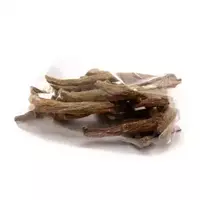Devyasila root

Since ancient times in Russia, the devil and its root was used "against nine ailments, " from where such an interesting name appeared for this plant. However, the relevance of the healing properties of the devyasila root is not limited to the ability to get rid of only nine diseases - its use is much wider.
It is worth noting that devyasil has other names, including divochil, yellow, elena grass, alant, somnit, divosil, yellow button, wild sunflower, bear ear, oman meadow, rough grass and animal grass.
In general, the devil belongs to the Astrov family and is a perennial herbaceous plant that grows in the form of a bush. It blooms in the 2nd half of summer, while spreading yellow or orange flowers, single or collected in large corymbose or racemose inflorescences. On the straight fleshy stem of this plant are oblong leaves pointed at the ends.
As a rule, devyasil grows quite abundantly in the European part of our country, in the Urals, as well as in Central Asia and Western Siberia. Mostly tall shrubs of devyasila can be found near water bodies, in quarries, ditches and in meadows.
As a medicinal raw material, as well as aromatic seasoning in the fall, it is customary to harvest devyasil root. For these purposes, tall plants are best suited, preferably older than 3 years, which have a straight thick stem. First, the devyasil is dug up, the soil is shaken, the ground part is cut off. After that, the devyasil root is washed, cut into small pieces and dried for several days in air.
In culinary affairs, essential oil is highly appreciated, which is obtained from the root of the girdle - it is used to flavour culinary products. In addition, the aromatic properties of the virgin root are relevant for the canning and fishing industries, where it is often added as a substitute for ginger and spice. By the way, the polysaccharide inulin, which is obtained from the root of devasil - the starting material for the manufacture of fructose.
In addition, devyasil and its root can be added to vegetable soup and other dietary first courses, red sauce or oyster porridge. The addition of this spicy plant to confectionery, compotes and other beverages contributes to the fact that the finished dish acquires a rather pleasant aroma.
In medicine, devyasila root is also used. As you know, it contains such valuable components as essential oil, in which the main part is gelenin, polysaccharides (pseudoinulin and inulin), a mixture of various types of lactins, resins, saponins, mucus, pigment, alkaloids, gum, acetic and benzoic acids, the bitter substance alantopicrin and vitamin E.
The useful properties of the devyasil root are due to its ability to stimulate metabolism in the body, as well as to exert anti-inflammatory, antimicrobial, antiseptic, anthelmintic, antifungal, anti-allergic and immunomodulatory effects.
root is 15 kKal
The energy value of the devyasil root (Ratio of proteins, fats, carbohydrates - ju):
Proteins: 2.9 g (~ 12 kCal)
Fats: 0 g (~ 0 kCal)
Carbohydrates: 0.2 g (~ 1 kCal)
Energy ratio (bj | y): 77% | 0% | 5%
 Español
Español Français
Français Português
Português Русский
Русский 简体中文
简体中文 繁體中文
繁體中文 日本語
日本語 한국어
한국어 العربية
العربية Türkçe
Türkçe Қазақ
Қазақ Deutsch
Deutsch Italiano
Italiano Українська
Українська
